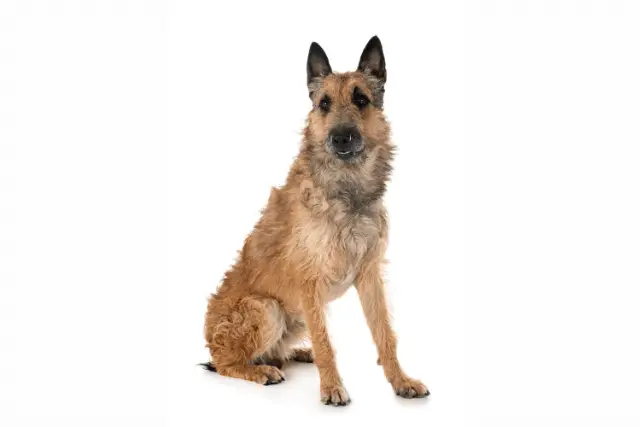Belgian Laekenois
The Belgian Laekenois is a member of the Belgian Shepherd family of breeds. The American Kennel Club recognized it in July 2020, and the Laekenois became a fully recognized breed. It was placed in the Herding Group alongside the other three; the Malinois, the Belgian Sheepdog (Groenendael), and the Tervuren.
The Laekenois is the least popular and was relatively unknown outside of Europe, but that doesn’t mean it is any less capable or intelligent than the other three breeds. This breed is known for its shaggy coat and endless energy levels. The Laekenois is an incorruptible shepherd that will do anything to defend their flock. Laekenois owners described them as;
- Loyal
- Hard-working
- Affectionate
- Great watchdogs
- Energetic
- Agile
- Loving
- Eager to please

Height:
22-26 in (56-66 cm)

Weight:
55-65 lb (25-30 kg)

Origin:
Belgium

Life Expectancy:
10-12 years
Dog Breed Characteristics
Like all other Belgian Shepherds, the Laekenois is a well-balanced, square-built dog with pointy ears and a muscular body. These dogs are strong and agile, making them great dog sport competitors. A male dog should reach a height of 24 - 26 inches, while the females should reach 22 - 24 inches. Males can weigh 55-75 pounds, and females 45-60 pounds.
The Belgian Laekenois has a slightly pointed muzzle and medium-sized, brown to dark-brown, almond-shaped eyes that should never protrude. The thing they are most known for is their wiry, shaggy coat. The most significant difference between the Belgian Shepherds is exactly their coats, and their characters are nearly identical.
Belgian Laekenois temperament
The Laekenois, like the other Belgian Shepherds, is calm and confident. These dogs should never be overly shy or aggressive. The Laekenois can become possessive of their family members, and if they are not properly socialized, that can lead to aggression towards strangers. These dogs are natural herders. They were born to work, which is when they feel most comfortable and “at home.”

Laekenois makes incredible watchdogs; they are alert and completely aware of everything going on around them. These dogs do not like being left alone for too long and will demand their family’s attention. Like the rest of the Belgian Shepherd family, they are rather smart, which means their minds and bodies need to be challenged.
Make sure you have enough games you can play with your Belgian Laekenois and that they receive plenty of exercise each day.
Belgian Laekenois training
Training such an intelligent dog breed is essential for preventing the development of bad behavioral traits. Start training them as soon as they arrive at your house, and if you do not have time to work with such an active breed, maybe it is not the best choice for you.
If you are interested in properly training your Laekenois and are unsure where to start, you can always ask professionals for help. There are many puppy training programs and doggy schools that can significantly help you train an active shepherding breed. Most dog breeds do not take well harsh training methods and techniques, and Laekenois is one of them.
You should make training sessions exciting, and you will start noticing great results in a matter of hours. This Belgian breed is one of the most trainable dog breeds in the world, and it is no wonder they are often picked as military and police dogs.
Socialization
Like any other dog breed, the Belgian Laekenois should start the socialization process as soon as possible. Dogs that are not well socialized are prone to behavioral problems and might react badly to situations they are not familiar with. The Laekenois is naturally a protective and territorial breed, like the rest of the Belgian Shepherds, and proper socialization is the key to having a well-behaved and friendly dog.
There are many ways you can socialize your Belgian Laekenois, and the most important thing to do is to get your dog familiar with different situations they can find themselves in. Take your dog to dog parks where they can meet other dogs and people. They can learn to react accordingly and understand that they don’t need to be protective all the time.
It is also possible to socialize and teach your dog how to handle other pets, although they might never learn to “play nice” with other pets due to their high prey drive.

If you are interested in checking out other Belgian Shepherds, check out the Tervuren, Groenendael (Sheepdog), and Malinois.
Laekenois as a pet
The Belgian Laekenois dogs are incredibly active and can be too much to handle for inexperienced owners. They require a lot of daily exercise and mental activity. These dogs need to be in a fenced area because their high prey drive makes them chase everything that is moving; a cyclist or a squirrel makes no difference as long as they can pursue them.
These dogs can be great playing partners for kids, especially if they grew up together. However, they can have a nipping tendency, so teaching your dog not to herd children is crucial. It is also essential not to let this type of behavior “pass by,” and you should always correct unacceptable behavior. These active dogs might not be the best choice for families with other pets.
Coat and care
The coat of the Belgian Laekenois is relatively easy to take care of. They need regular weekly brushing that will help them get rid of dead hair. Their wiry coat sheds moderately all year, but twice a year (during the shedding season in spring and fall), they blow their entire undercoat. Daily brushings will help you control the mess and help your dog through the heavy shedding period.
They will also need other basic care; brush their teeth at least three times a week. Check their ears for signs of infection and redness, bathe them every 6-8 weeks (more if they live inside the house), and trim their nails if they don’t wear them down naturally.

Health problems
Like any other dog breed, the Belgian Laekenois can potentially develop health problems. If you are buying a dog, make sure the breeder can provide you with the necessary health tests and guarantees. Always ask to see the results of tests from the puppy’s parents. The health problems these dogs are associated with are:
- Hypothyroidism - A health problem caused by hyperproduction of hormones from the thyroid gland.
- Epilepsy - Brain problem causing mild to severe seizures.
- Hip dysplasia - Genetic problem affecting hips resulting from an improperly formed hip joint.
The Laekenois is generally considered a very healthy breed that can live 10 - 12 years.
Belgian Laekenois breeders
When getting a dog, the most important thing is to get it from a responsible and reputable Belgian Laekenois breeder. These dogs are energetic and protective, and getting a poorly bred dog can have catastrophic results. Responsible breeders will breed dogs that don’t only look good but have great characters as well. You must find a good Laekenois breeder that can help you learn about this breed and make an informed choice about getting a dog with these characteristics.
If you are unsure whether this is the breed for you, check out this FREE GUIDE that will help you decide which dog breed is right for you.
Photo by: Louise De Bruyne
World Dog Finder team

Updated at31.08.2023.
Breed History
The history of the four Belgian Shepherd dogs began in the late 19th century when veterinary professor Adolphe Reul and his panel of judges determined which shepherd dogs from that area had Belgian roots. They concluded that square-built dogs, with pointy ears and muzzles and dark eyes, were the Belgian sheepherding dogs. They also concluded that these dogs could differ only by the texture and the length of the coat.
The Belgian Laekenois was named after the Belgian town of Laeken, where these dogs could often be found patrolling pastures and farms. They were also known for their work as guardians of the linen fields. It is believed that this is the oldest of the four Belgian Shepherd breeds, but like the other three, its complete history is unknown. Only recordings started after Adolphe Reul assembled the Belgian Shepherd Dog Club.














Share